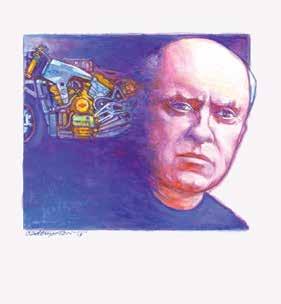
4 minute read
INDUSTRY RESEARCH
Dealernews Research By Dr. Paul Leinberger
KICKING ASS IN A TIME OF CRISIS Consumer Confidence Survey Says…
September marks the beginning of Fall and it is the month when many businesses begin their planning and budgeting process for the year ahead. One important aspect of the planning process is gauging consumer sentiment. Understanding consumer sentiment is critically important because more than 70% of the nation’s GDP is driven by consumer spending. Understanding how your customers feel when they walk through your doors (either virtually or properly socially distanced) may be the difference between success and failure in the coming year.
The amount of confidence Americans have in the economy and their own financial security has an excellent record of predicting the future. When consumers feel financially secure and are optimistic about the year ahead, they tend to increase their discretionary spending – on products like motorcycles and ATVs, and the economy grows. When they are worried about their financial future and are uncertain about what the future might bring, they tend to spend only on the products they need, and the economy slows.
Given the level of uncertainty that still pervades our lives and the very real possibility that COVID-19 could be with us through much of 2021, it is more important than ever to understand how consumers are feeling. The future of your business may depend on it.
Every month The Conference Board, a member-driven think tank, does a Consumer Confidence Survey ® that reflects prevailing business conditions and likely developments for the months ahead. The report details consumer attitudes and buying intentions and is a widely accepted measure of consumer sentiment. In August, the Conference Board Consumer Confidence Index ® declined sharply.
“Consumers’ optimism about the short-term outlook and their financial prospects declined and continues on a downward path,” said Lynn Franco, Senior Director of Economic Indicators at The Conference Board. “Increasing concerns amongst consumers about the economic outlook and their financial well-being will likely cause spending to cool in the months ahead.” The percentage of consumers claiming business conditions are “good” declined to 16.4%, while those claiming business conditions are “bad” grew to 43.6%.
Consumers also indicated that they are increasingly pessimistic about the next six months. Only three-in-ten (29.9%) consumers believe business conditions will improve over the next six months while those who expect business conditions to worsen grew to 20.5%.
The good news, if you can call it that, is that the sentiment index is not nearly as pessimistic as it was in the two most severe recessions that occurred in 2008 and 1980. To an optimist, the sentiment index suggests consumers are cautiously optimistic and believe the economy will turn around sometime in the next year. To a pessimist, the sentiment index suggests that further declines are yet to come. Either way, consumers are uncertain about the future and uncertainty drives caution.
What is unique about the current downturn is that it cannot be reversed solely by economic policies. The Federal Reserve Bank can only do so much and federal and state fiscal initiatives can only partially alleviate the current crisis. The economic crisis will not end without a vaccine and effective treatment for COVID-19. Consumers understand this and it factors into their level of confidence.
The current crisis has not only impacted consumers’ finances; it has also impacted the rest of their lives. According to the University of Michigan’s Survey of Consumers, 45% of all consumers say their lives have changed a great deal due to the coronavirus, while just 20% reported little or no change. 60 percent are worried about their family’s health and 20% say they have been negatively impacted by required social isolation.
It is no wonder then, that consumers look to the future with uncertainly and a sense of caution.
What does this mean for you? You can expect consumer confidence to recover with fits and starts tied to progress on the coronavirus. For the next twelve months or so, become an armchair economist. Monitor closely The Conference Board’s Consumer Confidence Index ® and the University of Michigan’s Consumer Sentiment Index. Taken together, they will give you an excellent sense of how your customers are feeling. If your customers are growing more pessimistic, provide them with reassurance and stock your shelves with value-based products and increase your inventory of used bikes. If they are beginning to feel better, focus on your new products and give them reasons to visit you (either online or in person).
The recovery is likely to be slow. However, no one knows. So keep a close eye on the consumer confidence numbers and, as our fearless leader, Robin Hartfiel so artfully puts it, keep “kicking ass in a time of crisis.”

A perennial keynote speaker for the Motorcycle Industry Council's annual Communications Symposium, Dr. Paul Leinberger has become the powersports industry's de facto futurist/strategist. Dr. Leinberger is an expert in market/brand strategy and research with more than two decades of social trend forecasting, market strategy and strategic planning. Prior to joining TTD, he was Senior VP of GfK NOP, where he ran the company’s flagship consumer trend services, Roper Reports, as well as the company’s groundbreaking Global Visual Database. His client list reads like a Who’s Who of corporate America: Hewlett-Packard, Apple, Disney, Nordstrom, Microsoft, Levi Strauss, E.& J. Gallo Winery and Toyota, among many others. Prior to his global responsibilities at GfK NOP, Dr. Leinberger was the Corporate Manager in the Product Planning and Market Strategy department at Nissan North America. Dr. Leinberger holds a Ph.D. in organizational and social psychology and a Masters of Urban Planning (Highest Honors). He lives in Irvine, California, and his work can be seen at www.dennyleinbergerstrategy.com











